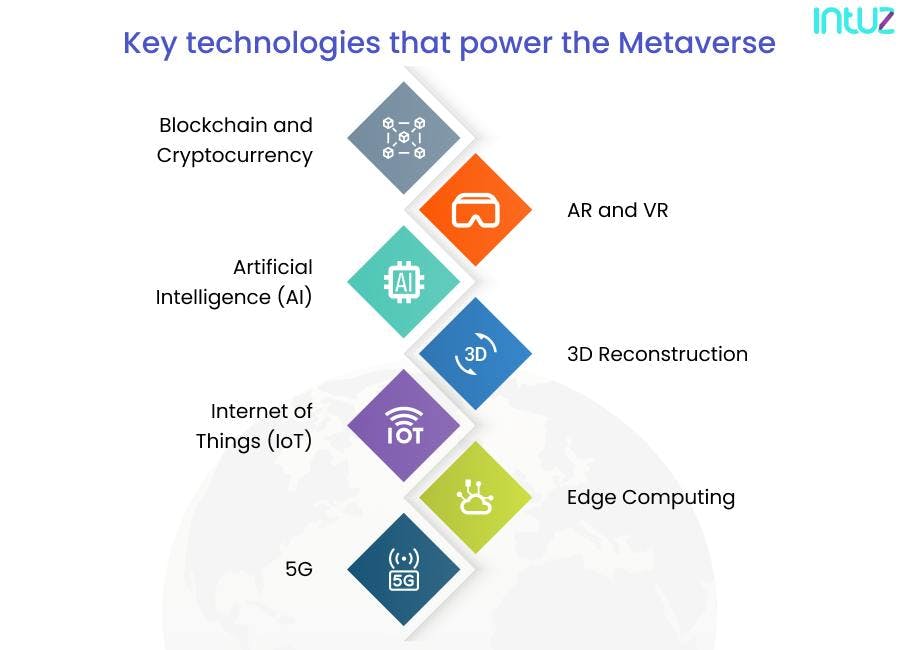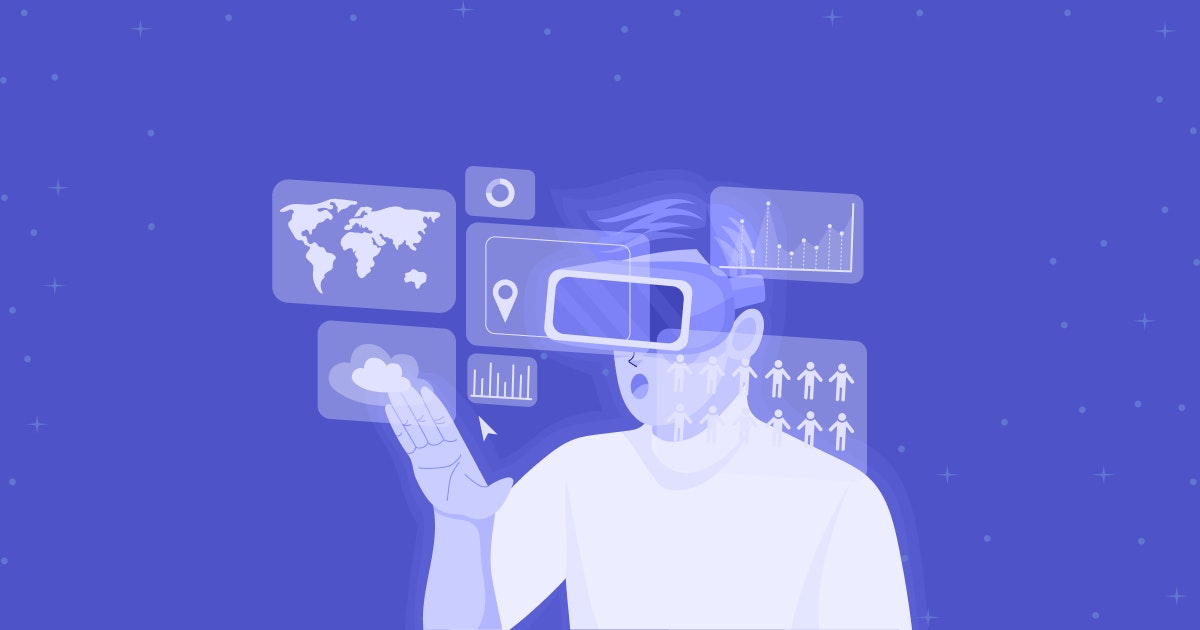Table of Content
If it were not for blockchain technology, many concepts that once seemed unreal or better off as theoretical concepts would not have come to life.
Who would have thought of making millions by selling unique digital collectibles in the form of music or art or using smart contracts to digitally facilitate the verification, control, or execution of an agreement - without human intervention.
Having a fully functioning economy inside a virtual world and dealing with virtual assets is something straight out of a sci-fi movie, but it is slowly becoming a part of our daily lives. Who would know this would be possible ten years ago?
Blockchain is transforming the digital space as we know it. The internet, more specifically, provides fantastic opportunities for users. From the emergence of static sites to leveraging Web2 experiences, there is no limit to what can be possibly achieved now.
The Metaverse, of course, is creating a buzz in our digitized way of living. The technology truly has the potential to shape the perfect digital reality based on blockchain as the latter enables the creator economy and offers enterprises decentralized infrastructure.
But what is the Metaverse?
Imagine a world where your digital life and physical reality were seamlessly connected. Metaverse is a four-dimensional version of the internet that converges augmented and virtual reality to offer an immersive experience.
The Metaverse is an exciting concept that promises to change how we interact with each other using technology. It is a 3D digital world where bespoke avatars allow you to explore virtual spaces using your imagination.
The new Metaverse environment provides immersive experiences for people of all ages to collaborate - without leaving their respective homes. It is like being in a video game or speaking to a hologram (think of Star Wars!). Wait, let us explain.
The latest development of the Metaverse
The idea of a Metaverse is not new. However, the term garnered much attention in October 2021 when Facebook changed its name to Meta.
The company's CEO, Mark Zuckerberg, announced the same year that his company would be spending $10 billion on developing the Metaverse.
They are currently working on the content and software for a future where he believes VR/AR will become as popularized as smartphones are today, allowing people to merge real-life and virtual reality with ease. But why the sudden interest in this technology?
The COVID-19 pandemic led to a culture of remote working and social distancing. With an increased demand for interactive ways to connect companies with their employees while keeping everyone safe, the interest in Metaverse accelerated.
The demand for virtual 3D spaces where you can join meetings with your coworkers, socialize and collaborate over projects virtually is on the rise. In November 2021, Microsoft launched Mesh, which features immersive spaces and avatars for users to engage in remote team meetings. How cool is that?
Most of us have experienced the Metaverse through video games. Pokémon Go was an Augmented Reality (AR) mobile game that first tapped into this new concept by allowing players to hunt virtual Pokémons in their surroundings.
The game conveniently brought together virtual and real-life using an app on the player's smartphone. Fortnite is another game offering a similar immersive experience by allowing players to host events and concerts inside a digital world.
Besides social media and gaming platforms, virtual worlds are being created by tech companies like Nvidia to streamline business operations. The company designed the Nvidia Omniverse as an open platform for connecting 3D spaces.
Engineers, designers, and creators can virtually collaborate in this shared universe and perform better. Several leading companies across different industries are already using the platform to enhance productivity.
For instance, the BMW Group uses the Omniverse to facilitate smart manufacturing. It helps reduce production time and improve product quality. This was not possible even five years ago! How technology evolves and pivots!
Key technologies that power the Metaverse

Key technologies that power the Metaverse
Companies are using cutting-edge technologies to make the Metaverse experience more immersive. This includes blockchain, AR, Virtual Reality (VR), and so on.
3D reconstruction can create realistic visuals of objects or people in the virtual world, while AI makes interactions with these creations seem less computer-generated. It adds human-like features such as emotions and decision-making to enrich the user's experience.
So, what are the key technologies that power the Metaverse or can play a crucial role in advancement? Let us find out:
1. Blockchain and cryptocurrency
Blockchain technology provides a decentralized and transparent solution for transacting in the Metaverse. It offers digital proof of ownership, digital collectibility, transferability, interoperability, and easy accessibility.
Cryptocurrencies are also built on blockchain technology, and they enable users to send or receive funds. It comes in handy while working or socializing with friends in the 3D world and there is a transaction that needs to occur.
For example, you can buy virtual lands in Decentraland using the game's cryptocurrency MANA. So, 16x16 meter land parcels are available for purchase in the form of Non-Fungible Tokens (NFTs). Blockchain keeps a record of ownership of these virtual lands. The ownership and transferability are established and secured for each piece of virtual land.
We are looking forward to a future where Metaverse-related jobs may also become available as many companies are moving their offices online for remote working. The payments for these roles would be made through crypto, and companies may even incentivize working in the Metaverse. The sky's the limit!
2. AR and VR
AR and VR are immersive 3D experiences that can give us entry into the digital world, but they differ slightly. One is more accessible than the other, but both can be used on almost any smartphone or digital device with a camera.
With AR applications, you can see your surroundings morphed with digital elements through your smartphone or a digital camera. At the same time, VR uses physical items such as VR headsets, gloves, and sensors to create a virtual environment.
AR applications allow users to view their real-life surroundings and make them interesting with interactive digital visuals. These features are found in the mobile game Pokémon GO, where players can locate Pokémons around them using their mobile phones.
On the other hand, VR works differently and is closer to the Metaverse concept. It produces an entirely computer-generated virtual environment that can be accessed through physical devices that support VR.
Current research into augmented and virtual realities shows an early model of what could be called the Metaverse. Virtual worlds are already being incorporated with fictional content, but as VR technology matures, we can expect the concept to expand or pivot.
Beyond recreating life-like virtual worlds, it will also include offering physical simulations with VR equipment. Users will feel like they are experiencing life in another part of the world or their country as they feel, hear and interact with people like in real life.
The Magic Of Metaverse: Sector-Specific Use Cases And Benefits
Learn More3. Artificial Intelligence (AI)
The potential of AI is immense, and it is being widely used in everything - from business strategy planning to facial recognition and faster computing. It is also being analyzed to study the possibilities of using AI in the Metaverse for a more immersive experience.
AI is fast becoming one of the most powerful tools in our technology stack for building the Metaverse. It enhances the ability to process and analyze data to provide valuable insights. Combined with Machine Learning (ML) techniques, it learns from historical data to create unique iterations for the future.
AI finds applications within the gaming Metaverse. It can be applied to the non-player characters (NPCs) to improve reaction and response in different scenarios. NPCs exist as a critical part of the gaming environment.
Designed to make the game more interactive by reacting and responding to players' actions, NPCs can be placed across the 3D spaces to facilitate life-like conversations.
Not only can AI NPCs run on their own and be used by millions at once, but also they have the capability to operate in different languages. Their advanced capabilities make them more flexible than their human counterparts.
The creation of Metaverse avatars is another potential application of AI. Metaverse avatars can be generated by running 2D images or 3D scans through AI engines.
These tools analyze the features of the images and process them to make the digital human look more realistic and accurate.
AI helps make the process dynamic by allowing users to create different facial expressions, hairstyles, clothes, and features to enhance the aesthetics of the avatars.
4. 3D reconstruction
With 3D reconstruction becoming more popular during this pandemic, real estate agencies have started using the technology to create virtual tours of homes. Similar to our imagination of the Metaverse, the tour allows buyers to look around the house and purchase them remotely.
3D reconstruction is a technology that can create realistic and natural-looking spaces in the Metaverse. With the help of this technology, we will be able to take our world online by rendering accurate models for buildings or objects.
Unique 3D cameras generate virtual replicas known as digital twins of physical objects. The game is changing fast for real estate, and consumers are lapping it up because the Metaverse technology helps them make a more informed decision.
5. Internet of Things (IoT)
IoT describes physical objects with sensors, software, processing ability, and other technologies that connect and exchange data with other devices and systems over the internet. Through communication networks, IoT helps collect data and remotely manage equipment, such as thermostats, voice-activated speakers, and even medical devices.
One exciting application of IoT on the Metaverse is to collect data from our physical world and use it to enhance the Metaverse experience. If this arrangement matures, it will allow for more accurate digital representations.
For instance, it can impact how particular objects function based on current weather conditions in the physical world. Implementing IoT technology will revolutionize connectivity between the 3D world and the real world.
It can seamlessly connect real-life devices with the ones in the Metaverse. The technology can help create real-time simulations in the virtual world. In addition to seamless data sharing, AI and machine learning can be used for managing and optimizing data collected in the Metaverse.
6. Edge computing
Edge computing is a big part of creating high-quality immersive virtual spaces. It is popularly used in IoT and IIoT networks to enable faster data transfer with fewer delays.
With millions of IoT devices joining the networks and virtual experiences, it has become impossible for the cloud to keep up with data storage and processing.
Edge computing is bringing the power of faster data processing closer to each device for an even better experience.
7. 5G
The Metaverse is delivering an entirely new generation of virtual experiences using 5G technology. Being the latest mobile trend, 5G has rapidly improved in recent years. Today, it is adept at providing the power necessary for real-time data transfers.
This next-generation mobile network allows VR devices to manage enormous amounts of data across the Metaverse. It will enable people to connect through AR and VR systems from anywhere, not just in their homes.
Even for deploying edge computing devices, a network requires more bandwidth. 5G makes VR rendering easier and quicker by enabling process edge devices to stream data without friction. It also indicates that the size of VR headsets could shrink in the near future. Besides being efficient in data processing, smaller VR headsets will be comfortable for users.
Challenges of the Metaverse
The Metaverse is a digital world where people can explore and interact with one another through their virtual avatars. Since the technology is in its early stages of development, there are some challenges we will need to overcome before it can become a reality.
One major problem is ensuring identity authentication and privacy control since there is no way to find the original identity of the user or who is actually behind the computer screen.
In the virtual world enabled by digital identities, bots or hackers could cause much harm by pretending to be someone else. This could lead to scams and fraudulent behavior, impacting the victim's reputation.
Privacy is another critical challenge to be addressed. AR and VR devices with camera capabilities are used in the Metaverse to offer an immersive experience.
Though these devices have unique identifiers, they are vulnerable to data breaches or undesirable personal information leaks without a robust data security mechanism.
Besides the above challenges, there is no way to mitigate the creation of harmful content and illegitimate environments. Stricter protocols are necessary to ensure harmless content is shared ethically and safely.
Over to you
We live in extremely interesting times, and how the Metaverse will evolve will be rather fun to watch. After all, this technology has the potential to shrink the world as we know it and make it much smaller, friendlier, and approachable.
However, the Metaverse is an upcoming open digital world that everyone can explore, but it is still under development. Several companies have already started exploring its potential, including Decentraland and The Sandbox.
Tech giants such as Microsoft, Facebook, and Nvidia are working on similar projects in the crypto space. They have recently invested in AI technologies to accelerate their development.
Though security is a key concern, it may not significantly impact until the Metaverse technology evolves far enough. If you want to know more about the concepts of Metaverse, crypto, NFTs, blockchain, and AR/VR, or want to discuss your IoT app development project, hop on a call with our specialists today!




